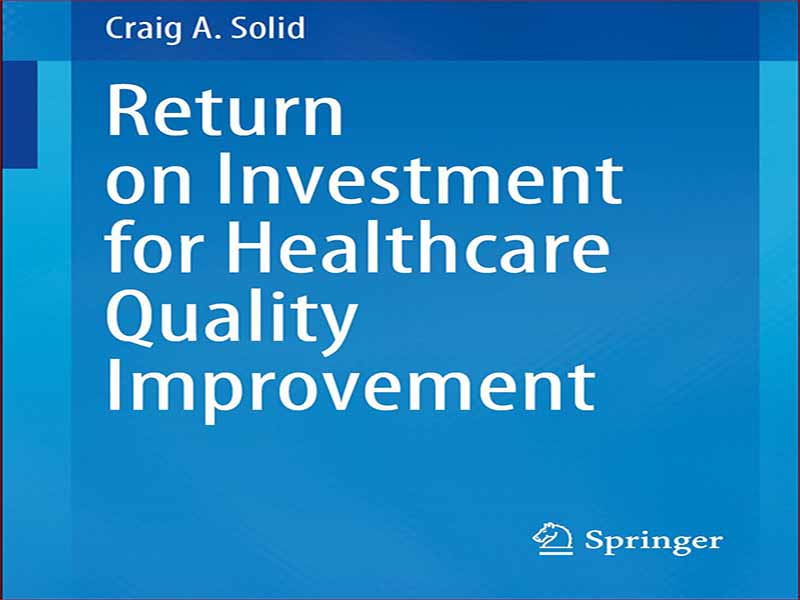- عنوان کتاب: Return on Investment for Healthcare Quality Improvement
- نویسنده: Craig A. Solid
- حوزه: سرمایه گذاری
- سال انتشار: 2019
- تعداد صفحه: 271
- زبان اصلی: انگلیسی
- نوع فایل: pdf
- حجم فایل: 4.91 مگابایت
ما در عصری زندگی می کنیم که شهرت تجارت در محاصره است. برای مثال، در میان دموکراتها، واژه «سوسیالیسم» اکنون بهتر از «سرمایهداری» نظرسنجی میکند. اما جمهوری خواهان، در حالی که بیشتر به برخی از ایده آل های تجاری توجه می کنند، در عمل خیلی بهتر نیستند. بسیاری از آنها به راحتی از دونالد ترامپ رئیس جمهور آمریکا در حملات او به تجارت آزاد، مهاجرت، برون سپاری، و رسانه های آمریکایی (که “دشمن مردم” نامیده می شوند) پیروی کرده اند – همه اینها اساساً موضعی ضد تجارت هستند. ، دست کم گرفته شده است، و بنابراین من در حال نوشتن یک کتاب مخالف هستم که اصلاً نباید مخالف باشد. همه انتقاداتی که ممکن است بر شکل شرکتی وارد شود – که برخی از آنها معتبر هستند – در مقابل دو فضیلت ساده و در واقع اساسی کمرنگ است. اول، تجارت بیشتر چیزهایی را که ما از آن لذت می بریم و مصرف می کنیم، می سازد. دوم، تجارت چیزی است که به اکثر ما شغل می دهد. دو کلمهای که فوراً از دنیای تجارت دنبال میشوند، «رونق» و «فرصت» هستند. بدون کسب و کار ما نخواهیم داشت: • کشتی، قطار، و اتومبیل • برق، روشنایی و تجهیزات گرمایشی • بیشتر مواد غذایی ما • بیشتر مواد دارویی نجات دهنده ما • لباس برای فرزندانمان • تلفن و گوشی های هوشمند ما • کتاب هایی که دوست داریم خواندن • امکان دسترسی کم و بیش فوری به بسیاری از اطلاعات آنلاین جهان و حقوق خود را فراموش نکنیم. برای استناد به عبارتی کهنه شده، «جلسه حقوق و دستمزد» چیزی کمتر از یک عمل قهرمانانه نیست. کسی یا گروهی کار سختی را انجام دادند و نوآوریهای مورد نیاز برای ایجاد یک شرکت را از ابتدا انجام دادند – من میدانم که اگر شما این کار را انجام ندادهاید، به اندازه کافی آسان است که این کار را مسلم بدانید. علاوه بر حقوق، مشاغل یکی از بزرگترین منابع غرور ما و راه مهمی برای ملاقات دوستان و ایجاد شبکه های اجتماعی هستند. به هر حال، وقتی از کلمه “کسب و کار” استفاده می کنم منظورم صرفاً “یک شرکت تجاری یا گاهی صنعتی” است تا یک تعریف سریع از Merriam-Webster استخراج کنم. من از کلمه دقیقتر قانونی «شرکت» به جای هم استفاده میکنم، حتی اگر این دو مفهوم کاملاً یکسان نیستند. یک بچه با غرفه لیموناد یک تجارت است اما یک شرکت نیست. با این حال، برای اهداف این کتاب، من نهادهایی را در نظر خواهم گرفت که به اندازه کافی بزرگ و رسمی هستند تا این دو کلمه به عنوان مترادف های مؤثر عمل کنند. من کاملاً درک می کنم که کلمه “کسب و کار” اغلب برای مردم بهتر از “شرکت” به نظر می رسد، بنابراین اگر گاهی اوقات از کلمه دوم استفاده می کنم باعث شوکه شدن برخی از خوانندگانم از رضایت ضمنی ضد شرکتی می شود.
The USA is experiencing rapid change in the healthcare industry and environment in both the public and private sectors. Significant upheaval in the private insurance market has occurred since the adoption of the Affordable Care Act (ACA) of 2010 [1] which yielded changes in the type and amount of insurance coverage offered as well as in the proportion of Americans receiving coverage. Coupled with the cultural and economic shifts in the overall healthcare landscape, an increased focus has been placed on the “value” of care, both as a concept and as a means to determine the appropriate level of payment or reimbursement for providers and facilities. Public payers, most notably the Centers for Medicare and Medicaid Services (CMS), have begun to move away from the more traditional “feefor- service” (FFS) payment model in favor of what is frequently referred to as a “value-based” system. Again, the ACA has played a critical role in this transition by specifically allowing for this type of payment design; it was further promoted by the Medicare Access and CHIP Reauthorization Act (MACRA) of 2015, which went a step further. Specifically, language withinMACRA mandated the creation of an incentive program for providerswhere their level of reimbursementwould depend, in part, on their performance on a variety of quality measures.1 Additionally, the CMS Innovation Center was established to test models that may help to improve care by aligning payment policies with proven practices for quality care delivery. As of this writing, the CMS Innovation Center displays more than 90 payment and care delivery models on their site in various stages of development or evaluation. [2]One of thesemodels is the Value-based Insurance Design, or VBID, [3] which is an attempt to explore different approaches to delivering and paying for health care for those covered under Medicare’s risk-based program, Medicare Advantage. The VBID model allows Medicare Advantage organizations to design benefit packages based on beneficiary characteristics, including some related to income. Additionally, these organizations must also develop programs to help beneficiaries plan for future care. Starting in 2021, the VBID will also explore hospice benefits for Medicare Advantage patients as a way to increase access and facilitate care coordination. This is particularly relevant given the significant increase in the proportion of Medicare beneficiaries who are enrolled in Medicare Advantage, from a low of approximately 13% in the early 2000s to a high of 34% (22 million individuals) in 2019 [4]. Given the stated pursuit of aligning payment policies with preferred care practices and the fact that more than one-third of all Medicare beneficiaries are currently enrolled in a risk-based model, clearly the role value plays will continue to gain significance in how health care is delivered and paid for, as will efforts to maximize the financial return of care programs and quality improvement. Risk-based models, which can often be considered to be value-based, are expanding in the private sector too. Numerous examples exist of private insurers moving to value-based payment mechanisms made possible, in part, because of the explosion in available data on enrollees. A report produced in 2018 by a task force of 41 providers and payers, including the likes of Aetna, Blue CrossBlue Shield, theCleveland Clinic, Kaiser Permanente, and the American Academy of Family Physicians, indicated that 47% of their members’ business was in value-based arrangements by the end of 2017, up from 30% in 2015 and on track to reach 75% by 2020 [5, 6]. In a 2018 survey of 120 payers, nearly $2 out of every $3 paid by those who responded were based on value, which corresponded to significant improvements in measures of quality and reductions in “unnecessary medical costs” [7]. Major payers, including UnitedHealthcare [8] and Cigna [9], have launched value-based initiatives, promoting them as a way to achieve better care at lower costs. All these signs point to a continued push away from FFS and toward value-based models. They signal a need for increasingly sophisticated methods for quantifying and evaluating value. At the same time of this shift, there is greater awareness of the value tied to the patient experience of care, quality of life, and efficiency in the systems and processes of care delivery. The explosion in the volume and availability of health data allows for more granular information on individual patients as well as the calculation of aggregate metrics to evaluate processes and outcomes. Patients, on the other hand, are demanding more of their care experience and encounters, including the recent push for “price transparency” from providers and facilities. Whether they realize it, they are really pursuing a better understanding of the “value” of the care they are receiving. That is, they want to know not only “What is the cost?” but “How does that cost compare to the quality of the care I received?” which can then be used to determine whether that cost is reasonable or fair.
این کتاب را میتوانید از لینک زیر بصورت رایگان دانلود کنید:
Download: Return on Investment for Healthcare Quality Improvement





































نظرات کاربران